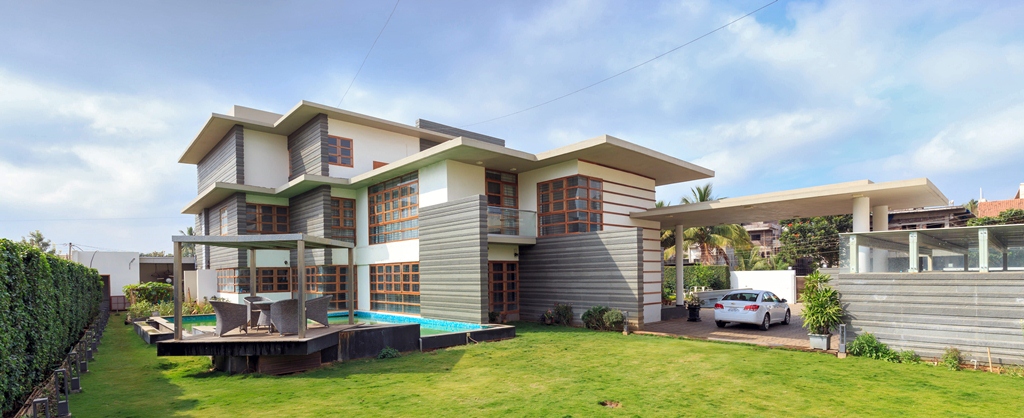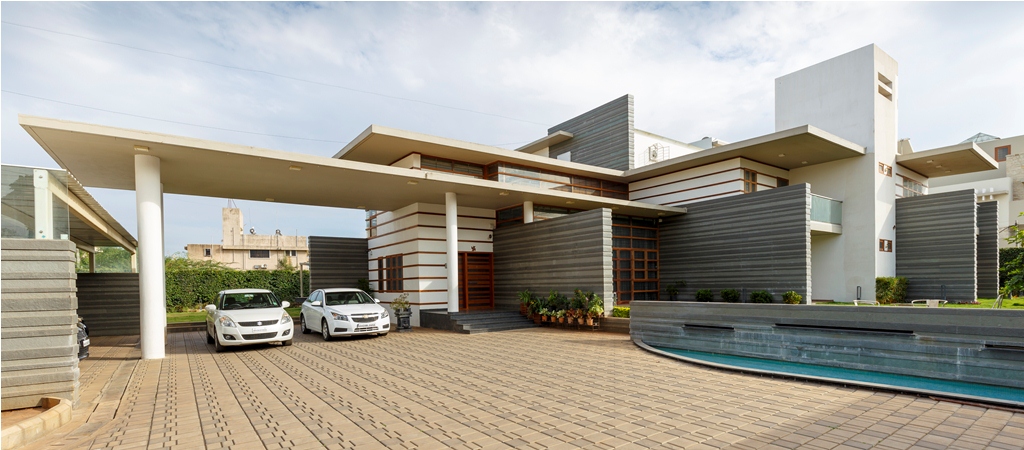The project is located in Ichalkaranji , small town in Maharashtra. Ichalkaranji is famous for textile – known as Manchester of India.
Taking inspiration of city’s famous textile weaving, the house is designed with patterns on walls , furniture and art. In the free flowing spaces, the interior decor creates defined spaces & gives warmth through its patterns and textures. White walls and glass also form a pattern completing the feel of Woven house.
Project brief
The project brief was to design a bungalow with large living areas with kitchen and dining. Family spaces with three master bedrooms, two children’s bedrooms and a guest bedroom. The house also needed home theatre, gym, library and a hobby room.
Context and Climate
Ichalkaranji falls in hot and dry climate zone with warm and humid monsoon. The design is based on climate responsive architecture with courtyard planning and high thermal mass walls. Open planning allowing natural ventilation through large openings covered by large overhangs – allowing diffused light and ventilation and blocking high solar radiation.
Design Philosophy
While designing a house it is impossible to separate architecture, interiors and landscape design as they have to compliment and not dominate each other.
Interior designing is not a afterthought, in fact the basic parameter for designing any space is interior layout.
Hence the design of any space starts with the interior designing itself.
The architectural form and the fenestrations in the building envelope are governed by interior layout.
The interior decoration gives character to the space hence appropriate use of materials, colours and textures is of paramount importance.
This project was a complete assignment of architecture, interiors and landscape designing.
Hence, it was a need to design architecture, interior and landscape in harmony with each other.
Concept
The architectural style of the bungalow is inspired by the city and its textile. The stone walls are designed as fabric pattern and its continues in interiors on wood and furniture. White walls and glass also form a pattern completing the feel of Woven house.
Planning
Spread on the large plot, this house has a simple plan which is derived out of functionality of spaces, catering to clients needs. The public and private spaces are segregated within the house.
Original idea was to create boundary-less spaces which flows into each other and then in the landscape. Interior decor complements the idea yet creates defined spaces keeping the flow of the spaces intact.
Public areas like living, dining and family are designed around the courtyard. All the spaces in the house flow in the landscape creating harmony with the nature.
Double heighted living and courtyard allow visual connection between the spaces at upper level . Glass railings help in enhancing this effect.
Design features
The palette for this project is grey stone and ceramic flooring, white painted walls enhanced with wood, which brings warmth in the decor.
The materials are used with surface variations creating subtle patterns , as per the theme of the house.
- Stone Cladding : The walls have been cladded with tandoor stone to achieve high thermal mass in hot- dry climate of the city. Pattern of tandoor stone cladding is inspired from textile. The strip pattern enhances free standing walls and continues from exterior to interior forming elements of interiors.
- Fenestrations : The windows are made of teak wood in order to match the rustic appeal of the house and seems as the continuity of the tandoor cladding.
Along with architecture and interior, even the artwork has been designed by us in the same ethos adhering to the theme of the woven house.
- Mural : a double heighted mural in the courtyard is another artwork inspired by the pattern. The wooden piece of art continues from ground floor to first floor. Wooden strips have been used forming patterns from nature in subtle way.
The mural is inspired by the five elements of nature :-
-
- Ether-(Akash) denoted as a globe.
- Earth- (Bhumi) associated as a plant
- Air-(Vayu)interpreted as bird in flight
- Water- (Jal) 70% of the earth’s surface is covered with water , hence depicted as Mother Earth
- Fire-(Agni) construed as a burning flame.
The mural and the courtyard compliments each other depicting the five elements in their own term. The space blends at the same time is enhanced by various architectural elements.
Even the furniture has been designed with detailing, creating unique style and decor. The pattern has been the soul of the woven house. The self pattern through placement of material on different levels has created beautiful and subtle texture throughout the house.
- Customized Sofa : Grey checkered pattern was an inspiration for sofa design. The square module is used creating seating at different levels. Grey floor, wooden carpet & grey shades of fabric sofa create an interesting element in the formal living area.
- Bedroom1 : Master bed has siporex art mural as the background wall. The organic form is generated as if the fabric is hanging on the wall. The curves and unevenness of the fabric is superiorly depicted through siporex mural.
- Bedroom 2 : Master bed with texture back panels and indirect lighting.
Green features
• Climate responsive architecture
• Ample daylight and ventilation – Common areas naturally ventilated
• Courtyard planning & Landscape as micro-climatic modifier
• Large overhangs to protect from solar radiation
• Thermal mass through stone masonry
Project Facts
Client: Mr. Abhijit & Shailendra Satpute
Architect: Ar. Sunil Patil, Sunil Patil & Associates
Interior Designer: Ar. Sunil Patil, Sunil Patil & Associates
Landscape Designers: Ar. Sunil Patil, Sunil Patil & Associates
Structural Consultants: S.S. Patne & Associates
HVAC : Jawed Patel
Plumbing Contractor: R. K. Dhavale
Civil Contractors: Aranjay Patil , Gagnan Walvekar
Mep Consultant:
Plumbing Consultant:
Interior Contractors:
Photo Credits: Sanjay Chougule
Commencement Date: Feb 2007
Completion Date: Sept 2014
Site Area: 17,550 sq.ft
Built Up Area: 8986 sq.ft
Cost: 1 Cr 83 Lac , 35,000 Sq. m
Project Team: Ar. Sunil Patil, Ar. Anuja Pandit, Er. Sanajy Patil


















One Response
The Best Architecture. The Best Interior design.
Sir You are The best.